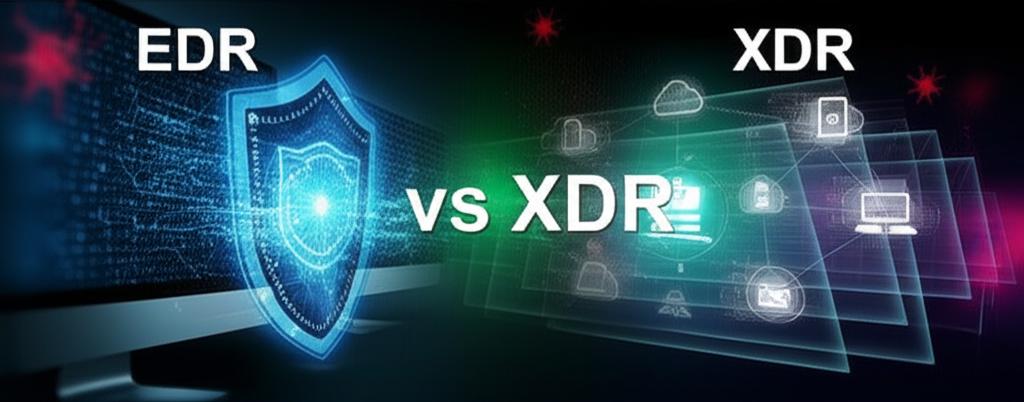EDR vs XDR: Understanding the Evolution of Threat Detection and Response
In today’s rapidly evolving cyber threat landscape, organizations are constantly seeking robust solutions to protect their digital assets. Two prominent technologies, Endpoint Detection and Response (EDR) and Extended Detection and Response (XDR), stand out as critical components of a modern cybersecurity strategy. While both aim to detect and respond to threats, they differ significantly in their scope and capabilities. This article delves into the core differences between EDR and XDR, helping you determine which solution is best suited for your organization’s unique needs.
What is Endpoint Detection and Response (EDR)?
Endpoint Detection and Response (EDR) is a cybersecurity solution focused specifically on monitoring and securing individual endpoints within an organization’s network. Endpoints include devices such as laptops, desktops, servers, tablets, and mobile phones.
Key Capabilities of EDR:
- Continuous Monitoring: Real-time collection and analysis of data from endpoints.
- Threat Detection: Identifies suspicious activities, malware, and other threats on endpoints.
- Investigation: Provides tools for security analysts to investigate alerts and understand the scope of an attack.
- Response: Enables actions like isolating infected endpoints, terminating malicious processes, and remediating threats at the endpoint level.
- Forensics: Gathers forensic data for post-incident analysis.
EDR excels at providing deep visibility into endpoint activities, making it highly effective for preventing, detecting, and responding to threats that specifically target these devices.
What is Extended Detection and Response (XDR)?
Extended Detection and Response (XDR) represents an evolution of EDR, offering a much broader and more integrated approach to cybersecurity. XDR goes beyond just endpoints, correlating data across multiple security layers to provide a unified view of an organization’s entire digital estate.
Key Data Sources for XDR:
- Endpoints: (Leveraging EDR capabilities)
- Network: Firewalls, intrusion detection systems, network traffic analysis.
- Cloud Workloads and Applications: Cloud infrastructure, SaaS applications.
- Email: Phishing attempts, malware in attachments.
- Identity: User behavior analytics, authentication logs.
- Data: Data loss prevention (DLP) systems.
Key Capabilities of XDR:
- Holistic Visibility: Provides a single pane of glass for all security data.
- Advanced Correlation: Uses AI and machine learning to correlate alerts and data across diverse sources, uncovering complex, multi-stage attacks that might be missed by siloed tools.
- Automated Response: Orchestrates automated actions across various security tools (e.g., block an IP on a firewall, disable an account, isolate an endpoint).
- Reduced Alert Fatigue: Consolidates and prioritizes alerts, presenting a clearer picture of actual threats.
- Faster Mean Time to Detect (MTTD) and Respond (MTTR): Streamlines investigation and response workflows.
XDR aims to break down security silos, offering comprehensive threat protection, detection, and response across the entire IT environment.
EDR vs. XDR: A Comparative Analysis
While both EDR and XDR are crucial for modern security, their differences lie in their scope, integration, and ultimate value proposition:
| Feature | EDR (Endpoint Detection and Response) | XDR (Extended Detection and Response) |
|---|---|---|
| Scope | Endpoint-centric (laptops, servers, mobile devices) | Extended (endpoints, network, cloud, email, identity, data, etc.) |
| Data Sources | Primarily endpoint telemetry | Aggregates data from multiple security tools and layers |
| Visibility | Deep visibility into endpoint activities, but siloed | Holistic, unified visibility across the entire IT environment |
| Threat Correlation | Limited to endpoint-specific events | Correlates alerts across diverse security domains to identify complex attacks |
| Automation & Response | Endpoint-level remediation and response | Orchestrated, automated response across multiple security tools and layers |
| Complexity | Easier to deploy and manage for endpoint-focused needs | Requires broader integration, potentially more complex to implement initially |
| Use Case | Strong point solution for endpoint security | Comprehensive threat defense, reduced alert fatigue, improved SOC efficiency |
When to Choose EDR?
EDR might be the right choice for organizations that:
- Are smaller in size or have a less complex IT infrastructure.
- Have budget constraints and need to prioritize endpoint security.
- Primarily face threats that are endpoint-centric or can be effectively mitigated at the endpoint level.
- Are looking to upgrade from traditional antivirus solutions to more advanced endpoint protection.
When to Choose XDR?
XDR is increasingly becoming the preferred solution for organizations that:
- Operate in complex, hybrid, or multi-cloud environments.
- Are targeted by sophisticated, multi-stage attacks that span across endpoints, networks, and cloud.
- Need a unified security operations center (SOC) view to reduce alert fatigue and improve incident response efficiency.
- Are looking to consolidate security vendors and tools, or improve their overall security posture with integrated intelligence.
- Require advanced automation and orchestration capabilities to respond to threats more rapidly.
The Future of Detection & Response
XDR represents the natural evolution of threat detection and response. As attack surfaces continue to expand and threats become more sophisticated, a siloed approach to security is no longer sufficient. XDR’s ability to provide a comprehensive, correlated view of threats across an entire digital ecosystem positions it as a cornerstone of future cybersecurity strategies, leveraging advanced analytics and AI to predict, detect, and neutralize threats more effectively.
Conclusion
Both EDR and XDR play vital roles in modern cybersecurity. EDR provides robust, focused protection for endpoints, while XDR offers a holistic, integrated defense across the entire IT environment. The choice between them depends on your organization’s specific needs, budget, and the complexity of your threat landscape. Many organizations start with EDR and then evolve towards XDR as their security needs mature and their attack surface expands, ultimately aiming for a more resilient and integrated security posture.







